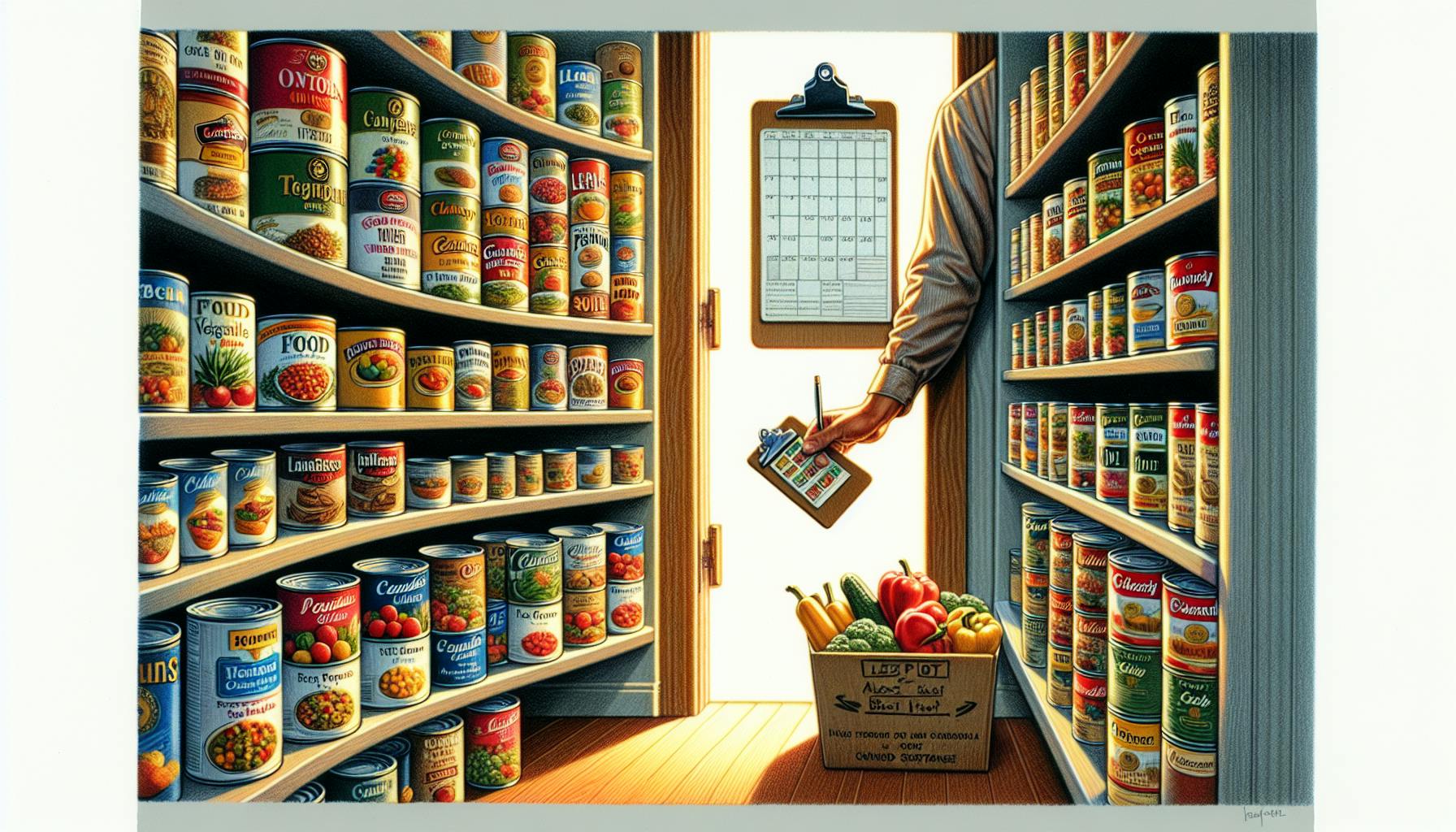Introduction
A crisis can disrupt normal supply chains and lead to shortages of many everyday foods we take for granted. Recent world events like the COVID-19 pandemic gave us a glimpse of just how quickly grocery shelves can empty when panic buying sets in. Being prepared with a well-stocked pantry is crucial to ensure your family won't go hungry if a hurricane, economic collapse, or other disaster strikes. This article will cover the non-perishable staples, fresh foods, and essential extras you should stockpile now before they disappear in an emergency. Having at least a 3-6 month supply of shelf-stable nutrition will provide invaluable peace of mind when crisis strikes. Let's dive in and explore the key items that often vanish first when SHTF (shit hits the fan).
Non-Perishable Staples
Non-perishable foods with long shelf lives should form the foundation of your stockpile. Rice, beans, canned goods, honey and other pantry basics pack a nutritional punch and require no refrigeration. Experts recommend having at least a 3-6 month supply. Here are some of the most crucial categories:
Canned & Jarred Foods
Canned tuna, chicken, vegetables, fruits and soups will last 2 years or more when unopened. Go for low sodium options like no-salt-added beans and cans without preservatives when possible. Variety helps beat food fatigue, so stock up on different flavors, types and meal possibilities.
- Essentials like canned beans, diced tomatoes, fruits packed in juice rather than syrup
- Convenient, shelf-stable nutrition and flavors
- Opt for BPA-free linings and watch expiration dates
- Emergency Food Supply Kits offer budget-friendly canned good variety
Some examples to stock up on:
- Canned tuna or chicken (at least 10 cans per person)
- Canned vegetables like carrots, peas, corn, green beans (20 cans per person)
- Canned beans like chickpeas, kidney beans, black beans (at least 15 cans per person)
- Canned fruits like pineapple, peaches, pears, apple sauce (10-12 cans per person)
- Soup cans like chicken noodle, tomato, vegetable (6-8 cans per person)
Grains
Rice, pasta, oats, quinoa and other grains are very long-lasting and packed with energy. Storing them in airtight containers will prolong freshness. Consider whole grains which retain more nutrients compared to refined white varieties.
- Rice, barley, wheat berries provide versatile staples
- Look for Emergency Food Supply Kits with bulk grains
- Ensure adequate ventilation if stored in buckets
- Pair with beans for complete vegetarian protein
- Calculate suggested serving sizes per person (1 cup dry grains per day)
Some suggested grains and serving sizes per person for 3 months:
- White rice: 20 lbs
- Brown rice: 20 lbs
- Rolled oats: 10 lbs
- Pasta: 10 lbs
- Quinoa: 5 lbs
- Barley: 5 lbs
Dried & Dehydrated Foods
Lightweight, portable options like dried fruit, jerky and freeze dried meals come in handy for bug out bags when SHTF. With little moisture content, they keep for years when stored properly in airtight containers.
- Dehydrated apple slices, banana chips, trail mix
- Powdered milk, dried soups, freeze dried entrees for convenience
- Vacuum sealing optimizes shelf life
- Dried and Dehydrated Food Variety Packs offer variety
Fats & Oils
Don't underestimate the importance of fats and oils for survival preparedness. Their high calorie density provides fuel and makes other foods more palatable. Optimal storage in a cool, dark place extends shelf life.
- Coconut oil, olive oil, vegetable oil offer versatility
- Lard and shortening also have lengthy 1-2 year shelf lives
- Cool, dark place avoids rancidity; 1-2 years for opened oils
- Bulk Cooking Oils like vegetable, olive, coconut
Shelf-Stable Dairy & Alternatives
Maintain nutrition, calories and familiarity of dairy with powdered or UHT milk options. Non-dairy alternatives like shelf-stable almond milk work for those with lactose intolerance.
- Powdered milk preserves well if kept cool and dry
- Soy, almond and oat milk offer non-dairy options
- Look for discounted Powdered Milk Buckets
- 2+ years shelf life for unopened UHT milk boxes
Stocking Fresh Foods
Supplement your non-perishables with fresh foods like fruits, vegetables and eggs whenever possible. Canning, dehydrating, pickling and freezing extend the shelf life of produce from your garden or grocery store.
Root Vegetables
Hardy root veggies like potatoes, carrots and onions will last months if properly stored in a cool (55-60°F), dark place with moderate humidity around 60-70%. Great for soups and stews. Check regularly for soft spots or sprouting.
- Onions and garlic keep for up to 10 months
- Root Vegetable Variety Packs offer budget bundles
- Monitor humidity and temperature for optimal conditions
Squashes
Nutritious and versatile squashes like butternut can be stored for 1-3 months. Leave stem on and keep in a moderately cool, dark spot around 50-55°F. Check for soft spots, mold growth and discard affected squashes.
- Acorn, spaghetti squash provide variety
- Discounted Squash Bundles available
- Delicious seeds also packed with nutrients
Fresh Fruits
Apples, citrus fruits and pears have optimum shelf lives around 2-3 months when stored properly in cool temperatures between 30-40°F and moderate humidity. Canning, freezing and dehydrating preps them for long-term storage.
- Berries and grapes should be eaten quickly or preserved
- Monitor apples for spoilage like mold, mushiness
- Check Fruit Canning Equipment for preservation
Fresh Vegetables
Leafy greens, tomatoes and other vegetables require fast consumption or preservation within 1-2 weeks like blanching, pickling or pressure canning. Proper post-harvest refrigerated storage optimizes shelf life.
- Peppers, broccoli last 1-2 weeks refrigerated
- Pressure Canning Supplies make preservation easy
- Potatoes, garlic prefer cool, dry storage around 40-50°F
Fresh Herbs
Delicate fresh herbs like cilantro, parsley and basil are best used promptly, dried or frozen in oil or water to extend enjoyment for months. Proper storage is crucial.
- Drying preserves flavor if stored in airtight containers
- Herb Drying Racks available
- Refrigerate tender leaves in water for 1-2 weeks
- Freezing in oil or water also maintains flavor
Essential Extras
Beyond basic staples, stock up on comfort foods like coffee, chocolate and spices to enhance morale and nutrition. Snacks, condiments and vitamin supplements also prepare your emergency food stockpile for long-term disasters when fresh options are limited.
Seasonings & Condiments
Transform bland staples into delicious meals with salt, spices, sauces and other flavor enhancers. Consider variety and shelf life.
- Salt, pepper essential for seasoning
- 2-3 years shelf life for unopened condiments
- Spice Variety Packs add flavor
- Track expiration dates of opened items
Sweeteners
Honey, maple syrup and other natural sweeteners retain flavor and nutrition better than white sugar over multi-year durations. Store in cool, dry place.
- Brown sugar lasts longer than granulated
- Check honey jars for crystallization
- Discounted Honey Buckets available
- 1 year shelf life for opened honey
Snack Foods
Stock up on healthy, morale-boosting snacks like granola, nuts, crackers and bars that provide satisfying options beyond main meals. Seek long shelf life.
- Look for variety of flavors and textures
- Vacuum sealing optimizes freshness
- Bulk Snack Variety Packs offer savings
- Avoid snacks high in sugar or sodium
Coffee & Tea
Coffee and tea provide comfort along with caffeine to help you power through a tiring day in a SHTF situation. Stockpile at least a 6-month supply of favorite bean and tea varieties.
- Vacuum seal beans to lock in 2+ year freshness
- Bulk Coffee & Tea Kits
- Instant coffee granules as backup
Vitamin Supplements
Limited food variety in a disaster makes vitamin supplements even more essential. Stock up on at least a 6-month supply of multivitamins, vitamin C, D, zinc and other key nutrients.
- Potency fades over time so check expiration dates
- 1-Year Vitamin & Mineral Kits available
- Store in cool, dark place to preserve nutrients
- Rotate stock as you replenish
Key Takeaways
Having a well-rounded emergency food stockpile with at least a 3-6 month supply of staples, fresh foods and supplements will prove invaluable for survival and resilience when SHTF. Start preparing your stockpile now before everyday items disappear in a future societal collapse, climate crisis, pandemic or other disaster that disrupts normal supply chains. With some planning and budgeting, you can ensure your family never goes hungry no matter what lies ahead on the road to self-reliance.


